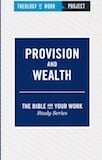Pharaohs Tried to Take It With Them
Blog / Produced by The High Calling
Egypt's Giza pyramids burned red in the fiery light of dawn. Grasping the reigns of a spirited Arabian horse, thundering over Sahara dunes, I could still admire these colossal monuments, giant tombs . . . headstones rivaling Trump Towers. They testified to the pharaohs' intimidating might and power, even in their deaths.
Later, wandering in the cavernous Cairo Museum, I saw photographs of the opening of the Tomb of Tutankhamen in the Valley of the Kings, a large burial chamber loaded to the top with stuff: couches, robes, vases, necklaces, gold pendants, stools, chairs, hassocks, weapons, chariots . . . storage for a monarch's garage sale.
A tomb's size directly reflected a pharaoh's importance. And the amount of stuff crammed into the burial chamber measured his magnitude—like some offices I've seen on Wall Street.
So contrast the pharaoh's jammed monuments with the tomb of Jesus. It wasn't his; it was borrowed. And his tortured body lay alone on a cold stone shelf.
Even in death, Jesus mocks our pretense and greed, challenges our noisy egos, yapping for recognition. The most important person in history, King of kings and Lord of lords, lay in a borrowed tomb, simple and bare.
It wasn't that he abhorred greed—on the contrary; but he taught us to channel it differently: store up for yourselves treasures in heaven, where neither moth nor rust consumes and where thieves do not break in and steal (Matt:6:20). Jesus' tomb was visibly empty but spiritually stuffed, testament to his humility and sacrifice, even in death.





